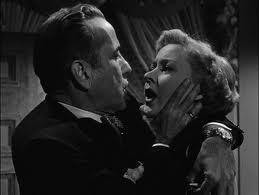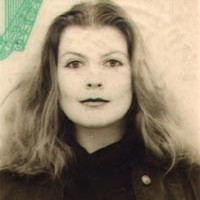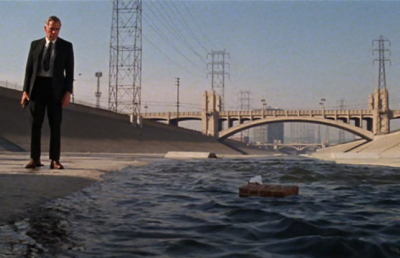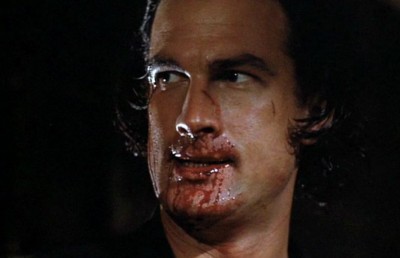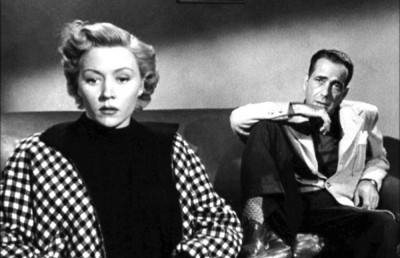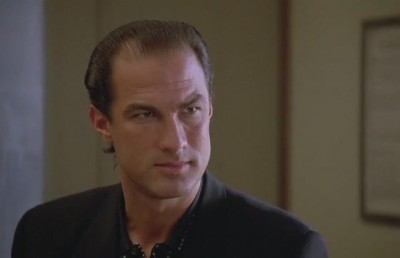Hollywood Can Be a ‘Lonely Place’: In a Lonely Place (1950) Part 2
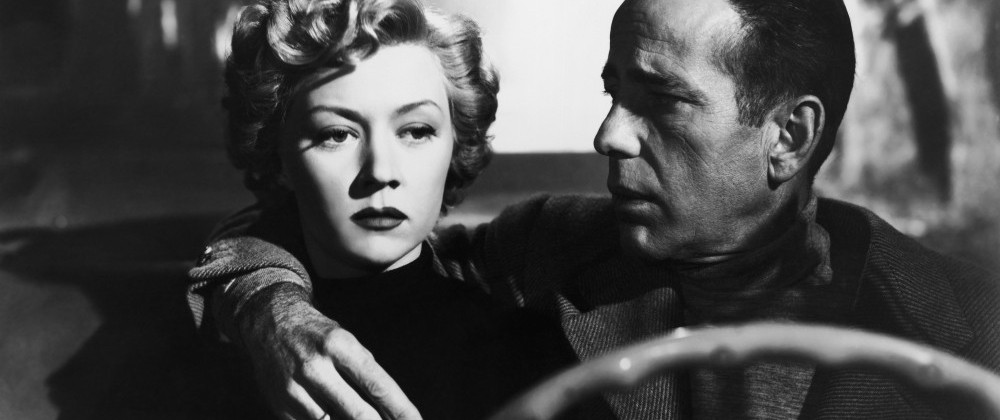
“For thy sweet love remembered such wealth brings,
That then I scorn to change my state with kings.”
Sonnet XXIX
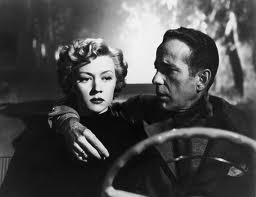
Dix ‘mugs’ Laurel
The film In a Lonely Place is a clarification of the culture of the film business and Hollywood. We are presented with the artefacts and effects of the industry and its malcontents. Dix must be a nice guy when you look at who’s on his payroll: Charlie ‘The Thespian’ Waterman (Robert Warwick), a down on his luck, brandy-swilling actor who looks as if he’s in costume when celebrating the engagement of The Princess to his chief benefactor. Mildred’s killer, Kesler, is named after one of the film’s producers. Dix’s remark about income tax is a swipe at Bogart’s own high-earning status offscreen. Agent Mel Lippman (Art Smith, whose career would shortly be ended by being named both by Elia Kazan and Clifford Odets) is another nice guy – who takes a punch from Dix during dinner and doesn’t tell him to get a new agent. When Laurel asks him why Dix can’t be like other people, Mel explains, “You knew he was dynamite. He has to explode sometime.” He is clearly convinced of Dix’s worth. Brub says Dix was a great C.O. in the war – and this is partly why Chief Lochner gives Dix the benefit of the doubt and telephones him with the apology after Kesler survives surgery long enough to confess to Mildred’s murder. (It’s too late to save Dix and Laurel’s relationship, but it’s the afterthought that counts). In the noir film, the problems within the institutions of policing and the law are also highlighted in the narrative. Here it’s an act of empathetic imagination that solves the crime, and therein lies the problem: the police simply lack the brainpower – as Sylvia sympathetically tells her husband, he’s average.
Industry in-jokes dot the screenplay: the first scene at Paul’s has a silly autograph hunter look for Dix’s signature only for a similarly pre-teen hound to inform him that Dix is a nobody; two old dames request souvenir matchbooks so they can show off their visit to a famed Hollywood haunt when they get back home to Nowheresville; and the vile studio executive insults Waterman, who retorts that he’s put the son-in-law business back by 50 years. Then Dix punches him out. (There is a later reference to David O. Selznick by Lippman, a reel-life example of the phenomenon of the son-in-law rising department of the studios.) There’s a reference to the El Morocco, a famous Hollywood nightclub. When Mildred gets to Dix’s apartment she claims she thought actors made up their own lines. Dix retorts, “when they get to be big stars they usually do.” Dix doesn’t even bother reading the potboiler he’s supposed to be adapting because it’s obviously like every other contemporary epic about love affairs in what passes for high society, a suspicion confirmed by Mildred and her repeated mispronunciation of ‘Al-e-thea’ Bruce when she sums up the lousy plot: in meta-cinematic fashion we might even detect here a reference to Ray’s most recent film, the woman’s melodrama, Born to Be Bad (1950) an adaptation of a popular novel which boasted a male character, Curtis (Zachary Scott) undone by a bad woman, Christabel (Joan Fontaine) and who blames his own loucheness and stupidity on his having given up flying (albeit not in wartime) rather like the Dixon Steele character in the Hughes novel. Ray’s preceding film, A Woman’s Secret (1949) relies on flashbacks (a close narrative relative of Dix’s crime scene recreations here) and music, particularly songs, to communicate emotion –reminding us of the significance of Hadda Brooks’ delivery of the lines “I Hadn’t Anyone Til You …” which is swiftly juxtaposed with the disturbance of a cop’s entrance. Law and order is not being mocked but Brooks is another exemplar of Ray’s Hollywood outsider; we are being confronted with difference that speaks the truth. When we are familiar with the body of a filmmaker’s work, the texts become rich in reference and allusion, the juxtapositions, like this one, more startling and resonant. And this is a hall of mirrors account of cinematic fictions. When Brub arrives at Dix’s apartment to bring him in after Mildred’s murder he tells him that he reminds him of The Worst Years of Our Lives, a jab at the Oscar winner.
Laurel is immediately categorised as a small-time actress and therefore likely fodder for men: Mel looks her up in a casting directory and says she’s been in a couple of low-budget productions: she is literally catalogued. Dix unconsciously repeats Laurel’s compliment about Dix when he comments that she has a wonderful face. In this narrative, women are currency, bought and paid for and kept and endlessly, serially exchanged between men. This is the film’s analogy with the novel’s evocation of serial killing. (In the novel, when Dix thinks about Laurel, “he wondered who was keeping her.” (Hughes: 62).) Dix thinks he might even have a role for her in the epic that so entranced Mildred before she was strangled – the eponymous Althea Bruce (the title alluding to the motivation for the novel’s version of Dix.)
Laurel’s previous relationship with Baker is likened to that of Mildred’s with her killer. Her relationship with Dix is also likened to his previous relationship – with Frances, the actress whose nose he allegedly broke when he was giving her a beating. This is also a film about men and women.
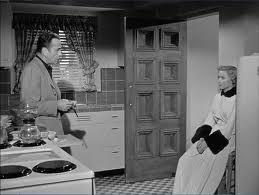
The last breakfast
Dix arrives at Laurel’s apartment and reverses the previous breakfast scene, straightening out a grapefruit knife because he doesn’t have enough cuisine savvy to realise that it’s meant to be curved. This big love scene is played by Dix as though he’s enacting a scene from a movie: “I love the love scene, it’s very good,” Laurel tells him. He replies, “Well that’s because they’re not always telling each other how much in love they are. A good love scene should be about something else besides love – for instance, this one. Me, fixing grapefruit, you, sitting there dopey, half-asleep. Anyone looking at us could tell we were in love.” The dynamism of the scene’s staging comes from the gap between them, him standing at the countertop, her seated at the refrigerator by the door. He is unable to interpret the tone of his own scene – he thinks they are playing at breakfasting like any married couple, he makes an effort at proposing marriage. His words are at odds with the evident mood and her churning emotions. He is oblivious to her feelings. He is the writer and he is telling her like it should be. She is trying to show him how it is. Antheil’s string arrangement underscores the tension. This is another of the ways in which the film calls into question its own meaning and process of representation – as well as changing the terms of its own spectatorship. It is also clever writing – Bernard Eisenschitz reminds us of Ray’s notes on his annotated script, “Nobody saying what they think.” (Eisenschitz: 138). On the contrary – they are saying what they say in movies. These disruptions – and this scene is an especially lengthy one relative to the rest of the film’s 91 minute running time – raise the prospect of the deal with the audience being re-negotiated on a new level. Mel misinterprets the situation but Martha does not. There is a sea of difference in the semaphore of men and women and this situation encapsulates it. [1] We are reminded of Dix and Laurel’s first conversation in his apartment when she tells him about leaving her real estate mogul: “We were going to get married. It wouldn’t have worked.” They occupy an echo chamber of failures.
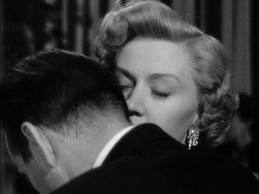
“I hadn’t anyone til you…”
The extraordinary close-up during the song in the nightclub, when Dix and Laurel’s sexual symbiosis is interrupted by the watchful policeman using his role in the investigation to upscale his social status with a night out somewhere he would never normally frequent, marks a sudden break in the noir photographic style. The generic code is being destabilised, and with it, the audience’s expectations and sense of ease. If In a Lonely Place belongs to the subset of noir known as hard-boiled, what to make of this situation?
The entire screenplay is an ingenious construction, based on one simple conceit: every scene is played over, in a different setting, and with a different outcome. This, then, is a film of two halves with a Russian-doll touch, a nesting-egg of richly ironic textual proliferation. The final twist of the narrative knife occurs over Dix’s script – Mel and Laurel have taken the unfinished work and given it to the producer in an act of utter betrayal, as Dix sees it. He picks up the phone call from Martha that is intended for Laurel and he hits Mel in the face.
Director Curtis Hanson spoke of the film as inspiration for L.A.Confidential (1997), another adaptation of a novel set in the tawdry background of the corrupt city and its dirty policemen which sparked interest:
To me, what is so incredible about his performance here is that, at the time, he was a major movie star and he could have done just about anything he wanted to do, especially on a movie with a budget as small as this one’s, Mr. Hanson said. Yet this is what he chose, and it’s such a naked performance. It is so ugly at times, truly and physically ugly. It’s what I love most about actors, their willingness to expose themselves. They won’t do it all the time. They won’t do it unless there are circumstances where there is trust. But that kind of collaboration between actor and director is, to me, the most important thing to aspire to. (Lyman, 2000)
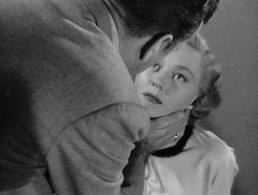
Dix shows Laurel just how dangerous he could be
As all of the above suggests, In a Lonely Place is also about Los Angeles – or more precisely, Beverly Hills and Hollywood. It was shot at several different locations in the vicinity: City Hall, at 455 North Rexford Drive; Villa Primavera at 1300-1308 North Harper Drive; West Hollywood; and mostly at the Columbia lot at Sunset and Gower. We recognise shots of Benedict Canyon, Santa Monica Boulevard, the Beverly Hills Post Office and Civic Hall, Inglewood and the opening scene, which takes place at the junction of Fountain Avenue with North Harper. Ray was careful about limiting the kind of architecture on display, determined to place Dix in conflict with his environment, which is mostly a version or imitation of what is known as California baroque (an appropriately plastic simulacrum, perhaps). The texture of this life is all.
Roger Ebert writes of the Beverly Patio apartment that serves as the locus of Dixon’s psychodrama,
The courtyard of the Hollywood building occupied by Humphrey Bogart in In a Lonely Place (1950) is one of the most evocative spaces I’ve seen in a movie. Small apartments are lined up around a Spanish-style courtyard with a fountain. Each flat is occupied by a single person. If you look across from your window, you can see into the life of your neighbor. (Ebert, 2009)

The apartment at Villa Primavera today
It was a replica of Nicholas Ray’s own apartment at Villa Primavera when he first came to Hollywood: was this really the lonely place in the glen dreamed up by J.M. Synge? During the filming Ray took to sleeping in his dressing room at the studio so as to minimise the possibility that either he or Grahame would get fired during their secret separation. As David Thomson reminds us in reference to Ray’s interest in architecture (he trained with Frank Lloyd Wright):
Few other directors had such a sense of the effect of locations and interiors on people’s lives, or the visual or emotional relationship between indoors and outdoors, upstairs and downstairs. Ray’s characters contract or expand according to the emotional tone of the place in which they find themselves.” (Thomson 1994: 614)
The co-ordinates of any scene are symbolised in the shot composition and the design of the location; the alternating clean horizontals, diagonals slashing the image and the blocking of actors behind room partitions or bars or even a piano, alerts us to the divisions between Dix and the other actors in his world. This might also be a gloss on Ray’s own Hollywood world, in which he assumed everyone else was experiencing his level of turmoil – they rarely were but it is a significant part of his legend as auteur that his work is read as a projection of his tortured self.
In a Lonely Place was released 17 May 1950, 4 months before the acerbic Sunset Blvd. (Wilder, 1950). The latter took all the kudos at the Academy Awards. To the onlooker, it would appear that Hollywood was not a safe place to work as a screenwriter. To the insider, it looked as if a truthful tale of morbidity and melancholy was etched onto negative. David Thomson says that In a Lonely Place
… is less showy than Sunset Boulevard [sic], but it is the truer portrait of Hollywood compromise and hypocrisy. The love affair between Bogart and Gloria Grahame fixes on one of Ray’s characteristic situations: lovers who are bad for each other. It was a situation from life (Thomson, 2003: 17).
The final, tragic embrace
The film performed somewhat disappointingly at the box office despite the positive critical response. It is a great love story that was perhaps doomed by its rational and adult conclusion – it simply is not sensible for Laurel to remain with Dix, not now, not after he came so close to killing her. The spiky configuration of relationships and shifting alliances in this most psychological of paranoid noirs may have been too much to accept. The contours are too sharp, too real. The rich narrative utilises ironising devices which serve to distance and destabilise audience expectations. We are reminded of the very first image – the fragmented screen, the fracture in perception and realise in retrospect it tells us everything we need to know about this world and this man’s experience of it. “I know the end,” Mildred tells Dix about Althea Bruce, “I always read that first.” It is a presaging of things to come, like the heraldic function of those phone calls that punctuate the storytelling. Dix Steele is Bogart’s greatest role, the modern, alienated man in a film truly existential in its inception and presentation. In the end this is as much a meditation on melancholy existence as it is a crime thriller or a movie-movie. To be inside the head of a screenwriter is the loneliest place of all.
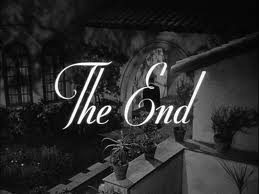
Endnotes
1 And we think of another grapefruit scene when James Cagney smashes half a grapefruit into Mae Clarke’s face in The Public Enemy (Wellman, 1931); and of course we flash forward to another kitchen scene with Gloria Grahame when she has a cup of scalding coffee thrown into her face by Lee Marvin in The Big Heat (Lang, 1953). This is always a film about films.
Bibliography
BooksBasinger, Jeanine (2007). THE STAR MACHINE. New York: Vintage Books.
Belton, John (1994). AMERICAN CINEMA/AMERICAN CULTURE. New York: McGraw-Hill Inc.
Bordwell, David, Janet Staiger and Kristin Thompson (1994). THE CLASSICAL HOLLYWOOD CINEMA: Film Style and Mode of Production to 1960. London: Routledge.
Casper, Drew (2007). POSTWAR HOLLYWOOD 1946-1962. Malden, Massachusetts: Blackwell Publishing.
Dancyger, Ken and Jeff Rush (1990). ALTERNATIVE SCRIPTWRITING. New York: Focal Press.
Eisenschitz, Bernard (1996). NICHOLAS RAY: An American Journey. (Translated from the French by Tom Milne.) London: Faber & Faber.
Friedrich, Otto B. (1997). CITY OF NETS: A Portrait of Hollywood in the 1940s. Berkeley and Los Angeles: University of California Press.
Hughes, Dorothy B. (1947 [2003] ) IN A LONELY PLACE . New York: Feminist Press, City University of New York.
Krutnik, Frank (1991). IN A LONELY STREET: Film Noir, Genre, Masculinity. London/ New York: Routledge.
Naremore, James (2008). MORE THAN NIGHT: Film Noir In Its Contexts. Berkeley and Los Angeles: University of California Press.
Polan, Dana (1993). IN A LONELY PLACE . London: British Film Institute.
Sarris, Andrew (1968). THE AMERICAN CINEMA: Directors and Directions 1929-1968. New York: Da Capo Press.
Shiel, Mark (2012). HOLLYWOOD CINEMA AND THE REAL LOS ANGELES. Reaktion Books.
Telotte, Jean-Pierre (1989). VOICES IN THE DARK: The Narrative Patterns of Film Noir. Urbana: University of Illinois Press.
Thomson, David (1994). A BIOGRAPHICAL DICTIONARY OF FILM. London: Secker & Warburg.
Truffaut, François (1978). THE FILMS IN MY LIFE. (Translated by Leonard Mayhew) New York: Simon & Schuster.
Journal ArticlesBrooks, Louise. ‘Humphrey and Bogey,’ in Sight & Sound, Winter 1966/7, Vol. 36: 1. Accessed 26 October 2012.
Crowther, Bosley (1950). ‘In a Lonely Place,’ New York Times, 18 May 1950. Accessed 27 October 2012.
Ebert, Roger (2009). “In a Lonely Place,” Chicago Sun Times, 13 August 2009. Accessed 26 October 2012.
Gonzales, Ed (2001). “In a Lonely Place,” Slant magazine, 27 June 2001. Accessed 26 October 2012.
Lyman, Rick (2000). ‘A Dark Lesson in Trust,’ New York Times, 15 December 2000.
Place, Janey and Lowell Peterson (1974). ‘Some Visual Motifs of Film Noir,’ Film Comment, January-February 1974. Accessed 31 October 2012.
Rich, B. Ruby (1995). ‘Dumb Lugs and Femmes Fatales,’ Sight & Sound, Vol.5, No.11, November 1995: 6-10.
Thill, Scott (2003). “In a Lonely Place.” Bright Lights Film Journal, May 2003, Issue 40. Accessed 26 October 2012.
Schrader, Paul (1974). ‘Notes on Film Noir,’ Film Comment, Spring 1972. Accessed 30 October 2012.
Thomson, David (2003). ‘The Poet of Nightfall,’ The Guardian, 27 December 2003, Arts section: 16-17.
Variety, ‘I Like His Face,’ 17 May 1950. Accessed 26 October 2012.
Copyright
All film stills copyright Santana Productions/Columbia Pictures. The image of the apartment is courtesy dearoldhollywood.

